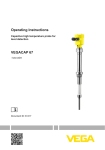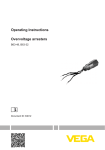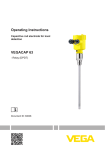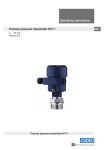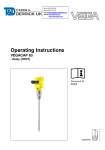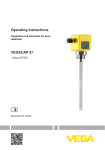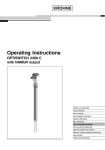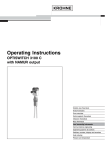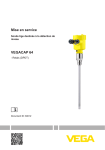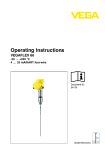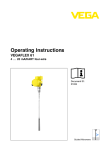Download Operating Instructions VEGACAP 64
Transcript
Operating Instructions Capacitive rod electrode for level detection VEGACAP 64 - transistor (NPN/PNP) Document ID: 30014 Contents Contents 1 About this document 1.1 Function ........................................................................................................................... 4 1.2 Target group ..................................................................................................................... 4 1.3 Symbolism used ............................................................................................................... 4 2 For your safety 2.1 Authorised personnel ....................................................................................................... 5 2.2 Appropriate use ................................................................................................................ 5 2.3 Warning about incorrect use............................................................................................. 5 2.4 General safety instructions ............................................................................................... 5 2.5 Safety label on the instrument .......................................................................................... 6 2.6 CE conformity................................................................................................................... 6 2.7 Safety instructions for Ex areas ........................................................................................ 6 2.8 Environmental instructions ............................................................................................... 6 3 Product description 3.1 Configuration .................................................................................................................... 7 3.2 Principle of operation........................................................................................................ 8 3.3 Operation ......................................................................................................................... 9 3.4 Storage and transport....................................................................................................... 9 3.5 Accessories and replacement parts ............................................................................... 10 4 Mounting 4.1 General instructions ....................................................................................................... 11 4.2 Mounting instructions ..................................................................................................... 12 5 Connecting to power supply 5.1 Preparing the connection ............................................................................................... 13 5.2 Connection procedure .................................................................................................... 13 5.3 Wiring plan, single chamber housing.............................................................................. 14 5.4 Wiring plan - version IP 66/IP 68, 1 bar........................................................................... 17 6 Setup 6.1 General information ........................................................................................................ 18 6.2 Adjustment elements...................................................................................................... 18 6.3 Function chart ................................................................................................................ 21 7 Maintenanceandfaultrectification 7.1 Maintenance .................................................................................................................. 22 7.2 Rectify faults ................................................................................................................... 22 7.3 Exchange of the electronics module............................................................................... 23 7.4 How to proceed in case of repair .................................................................................... 25 Dismounting 8.1 Dismounting steps.......................................................................................................... 26 8.2 Disposal ......................................................................................................................... 26 9 Supplement 9.1 Technical data ................................................................................................................ 27 9.2 Dimensions .................................................................................................................... 31 2 VEGACAP 64 • - transistor (NPN/PNP) 30014-EN-130916 8 Contents Supplementary documentation Information: Supplementary documents appropriate to the ordered version come withthedelivery.Youcanfindthemlistedinchapter"Product description". 30014-EN-130916 Instructions manuals for accessories and replacement parts Tip: ToensurereliablesetupandoperationofyourVEGACAP64,weoffer accessories and replacement parts. The corresponding documentations are: • • • 30174 - Electronics module VEGACAP series 60 34296 - Protective cover 31088 - Flanges according to DIN-EN-ASME-JIS-GOST Editing status: 2013-08-21 VEGACAP 64 • - transistor (NPN/PNP) 3 1 About this document 1 About this document 1.1 Function 1.2 Target group 1.3 Symbolism used This operating instructions manual provides all the information you need for mounting, connection and setup as well as important instructionsformaintenanceandfaultrectification.Pleasereadthisinformation before putting the instrument into operation and keep this manual accessible in the immediate vicinity of the device. This operating instructions manual is directed to trained specialist personnel. The contents of this manual should be made available to these personnel and put into practice by them. Information, tip, note This symbol indicates helpful additional information. Caution: If this warning is ignored, faults or malfunctions can result. Warning: If this warning is ignored, injury to persons and/or serious damage to the instrument can result. Danger: If this warning is ignored, serious injury to persons and/or destruction of the instrument can result. • → 1 Ex applications This symbol indicates special instructions for Ex applications. List The dot set in front indicates a list with no implied sequence. Action This arrow indicates a single action. Sequence of actions Numbers set in front indicate successive steps in a procedure. Battery disposal This symbol indicates special information about the disposal of batteries and accumulators. 30014-EN-130916 4 VEGACAP 64 • - transistor (NPN/PNP) 2 For your safety 2 2.1 For your safety Authorised personnel All operations described in this operating instructions manual must be carried out only by trained specialist personnel authorised by the plant operator. During work on and with the device the required personal protective equipment must always be worn. 2.2 Appropriate use The VEGACAP 64 is a sensor for point level detection. Youcanfinddetailedinformationontheapplicationrangeinchapter "Product description". Operational reliability is ensured only if the instrument is properly usedaccordingtothespecificationsintheoperatinginstructions manual as well as possible supplementary instructions. For safety and warranty reasons, any invasive work on the device beyond that described in the operating instructions manual may be carried out only by personnel authorised by the manufacturer. Arbitraryconversionsormodificationsareexplicitlyforbidden. 2.3 Warning about incorrect use 2.4 General safety instructions Inappropriate or incorrect use of the instrument can give rise to application-specifichazards,e.g.vesseloverfillordamagetosystem components through incorrect mounting or adjustment. This is a state-of-the-art instrument complying with all prevailing regulations and guidelines. The instrument must only be operated in a technicallyflawlessandreliablecondition.Theoperatorisresponsible for the trouble-free operation of the instrument. During the entire duration of use, the user is obliged to determine the compliance of the necessary occupational safety measures with the current valid rules and regulations and also take note of new regulations. The safety instructions in this operating instructions manual, the national installation standards as well as the valid safety regulations and accident prevention rules must be observed by the user. 30014-EN-130916 For safety and warranty reasons, any invasive work on the device beyond that described in the operating instructions manual may be carried out only by personnel authorised by the manufacturer. Arbitraryconversionsormodificationsareexplicitlyforbidden. The safety approval markings and safety tips on the device must also be observed. VEGACAP 64 • - transistor (NPN/PNP) 5 2 For your safety 2.5 Safety label on the instrument 2.6 CE conformity 2.7 Safety instructions for Ex areas 2.8 Environmental instructions The safety approval markings and safety tips on the device must be observed. ThisdevicefulfillsthelegalrequirementsoftheapplicableECguidelines.ByattachingtheCEmark,VEGAprovidesaconfirmationof successfultesting.YoucanfindtheCEconformitydeclarationinthe downloadareaof"www.vega.com". PleasenotetheEx-specificsafetyinformationforinstallationandoperation in Ex areas. These safety instructions are part of the operating instructions manual and come with the Ex-approved instruments. Protection of the environment is one of our most important duties. That is why we have introduced an environment management system with the goal of continuously improving company environmental protection.Theenvironmentmanagementsystemiscertifiedaccording to DIN EN ISO 14001. Pleasehelpusfulfillthisobligationbyobservingtheenvironmental instructions in this manual: • • Chapter"Packaging, transport and storage" Chapter"Disposal" 30014-EN-130916 6 VEGACAP 64 • - transistor (NPN/PNP) 3 Product description 3 Product description 3.1 Configuration Scope of delivery The scope of delivery encompasses: Constituent parts The VEGACAP 64 consists of the components: • • • • • VEGACAP 64 point level switch Documentation – this operating instructions manual – SafetyManual-31815"VEGACAP series 60 - Transistor (NPN/ PNP)"(optional) – Supplementaryinstructionsmanual"Plug connector for level sensors"(optional) – Ex-specific"Safety instructions"(withExversions) – ifnecessary,furthercertificates Housing cover Housing with electronics Processfittingwithelectrode 1 2 3 4 5 Fig. 1: VEGACAP 64 - with plastic housing 1 2 3 4 5 Thenameplatecontainsthemostimportantdataforidentificationand use of the instrument: 30014-EN-130916 Type plate Housing cover Housing with electronics Processfitting active screen segment active probe VEGACAP 64 • - transistor (NPN/PNP) 7 3 Product description 1 15 2 14 3 13 4 12 5 6 7 8 11 10 9 Fig. 2: Layout of the type label (example) 1 Instrument type 2 Product code 3 Approvals 4 Process and ambient temperature, process pressure 5 Power supply and signal output, electronics 6 Protection rating 7 Probe length 8 Order number 9 Serial number of the instrument 10 Material, wetted parts 11 Symbol of the device protection class 12 Reminder to observe the instrument documentation 13 ID numbers, instrument documentation 14 NotifiedauthorityforCEmarking 15 Approval directives With the serial number, you can access the delivery data of the instrument via www.vega.com,"VEGA Tools"and"serial number search". Inadditiontothetypelabeloutside,youcanalsofindtheserialnumber on the inside of the instrument. Area of application 3.2 Principle of operation VEGACAP 64 is a level switch with fully insulated, capacitive electrode with active screen segment and active tip for level detection. VEGACAP 64 is very rugged and maintenance-free and can be used in all areas of industrial process technology. Typicalapplicationsareoverfillanddryrunprotection. Fully insulated probes with screen segment like VEGACAP 64 are preferably used in conductive, very adhesive liquids. Due to the mechanical constructions of the active screen segment and the active tip, buildup on the probe can be compensated. The instrument can also be used problem-free in corrosive products. Functional principle 8 Probe, measured product and vessel wall form an electrical capacitor. Thecapacitanceisinfluencedbythreemainfactors. VEGACAP 64 • - transistor (NPN/PNP) 30014-EN-130916 The capacitive measuring principle places no special requirements oninstallation.Hence,manydifferentapplicationscanbeequipped with VEGACAP 64. 3 Product description 1 2 3 Fig. 3: Functional principle - Plate capacitor 1 2 3 Distance between the electrode surfaces Size of the electrode surfaces Type of dielectric between the electrodes The probe and the vessel wall are the capacitor plates. The measured product is the dielectric. Due to the higher dielectric constant of the product compared to air, the capacitance increases as the probe is gradually covered. The capacitance change is converted by the electronics module into a switching command. Voltage supply VEGACAP 64 is a compact instrument, i.e. it can be operated without external evaluation system. The integrated electronics evaluates the level signal and outputs a switching signal. With this switching signal, a connected device can be operated directly (e.g. a warning system, a pump etc.). Thedataforpowersupplyarespecifiedinchapter"Technical data". 3.3 Operation The probe can be adapted to the dielectric constant of the product directly on the electronics module. A switching command can be triggered when the probe is covered or laid bare. Ontheelectronicsmoduleyouwillfindthefollowingdisplayand adjustment elements: 30014-EN-130916 • • • • Packaging Signal lamp for indication of the switching condition (green/red) Potentiometer for switching point adaptation DIL switch for measuring range selection DIL switch for mode adjustment 3.4 Storage and transport Your instrument was protected by packaging during transport. Its capacity to handle normal loads during transport is assured by a test based on ISO 4180. The packaging of standard instruments consists of environmentfriendly, recyclable cardboard. For special versions, PE foam or PE VEGACAP 64 • - transistor (NPN/PNP) 9 3 Product description foil is also used. Dispose of the packaging material via specialised recycling companies. Transport Transport must be carried out in due consideration of the notes on the transport packaging. Nonobservance of these instructions can cause damage to the device. Transport inspection The delivery must be checked for completeness and possible transit damage immediately at receipt. Ascertained transit damage or concealed defects must be appropriately dealt with. Storage Up to the time of installation, the packages must be left closed and stored according to the orientation and storage markings on the outside. Unless otherwise indicated, the packages must be stored only under the following conditions: Storage and transport temperature Protective cap • • • • • • • Not in the open Dry and dust free Not exposed to corrosive media Protected against solar radiation Avoiding mechanical shock and vibration Storageandtransporttemperatureseechapter"Supplement Technical data - Ambient conditions" Relative humidity 20 … 85 % 3.5 Accessories and replacement parts The protective cover protects the sensor housing against soiling and intense heat from solar radiation. Youwillfindadditionalinformationinthesupplementaryinstructions manual"Protective cover"(Document-ID34296). Flanges Screwedflangesareavailableindifferentversionsaccordingtothe following standards: DIN 2501, EN 1092-1, BS 10, ANSI B 16.5, JIS B 2210-1984, GOST 12821-80. Youcanfindadditionalinformationinthesupplementaryinstructions manual"Flanges according to DIN-EN-ASME-JIS"(Document-ID 31088). 30014-EN-130916 10 VEGACAP 64 • - transistor (NPN/PNP) 4 Mounting 4 4.1 Mounting General instructions Suitability for the process Make sure that all parts of the instrument coming in direct contact conditions with the process, especially the sensor element, process seal and processfitting,aresuitablefortheexistingprocessconditions,such as process pressure, process temperature as well as the chemical properties of the medium. Youcanfindthespecificationsinchapter"Technical data"andonthe nameplate. Switching point In general the level switch can be mounted in any position. The instrument must be mounted in such a way that the probe is at the height of the requested switching point. Welding work Before beginning the welding work, remove the electronics module from the sensor. By doing this, you avoid damage to the electronics through inductive coupling. Handling With threaded versions, the housing must not be used to screw in the instrument. Applying tightening forces on the housing can damage its internal parts. Use the hexagon for screwing in. Moisture Usetherecommendedcables(seechapter"Connecting to power supply")andtightenthecablegland. You can give your instrument additional protection against moisture penetration by leading the connection cable downward in front of the cableentry.Rainandcondensationwatercanthusdrainoff.Thisapplies mainly to outdoor mounting as well as installation in areas where high humidity is expected (e.g. through cleaning processes) or on cooled or heated vessels. 30014-EN-130916 Fig. 4: Measures against moisture penetration Transport DonotholdVEGACAP64ontheprobe.Especiallywithheavyflange versions or long rod versions, the sensor can be damaged simply by the weight of the instrument. VEGACAP 64 • - transistor (NPN/PNP) 11 4 Mounting Pressure/Vacuum Theprocessfittingmustbesealedifthereisgaugeorlowpressurein the vessel. Before use, check if the seal material is resistant against the measured product and the process temperature. Themax.permissiblepressureisspecifiedinchapter"Technical data"oronthetypelabelofthesensor. Agitatorsandfluidization 4.2 Mounting instructions Duetotheeffectsofagitators,equipmentvibrationorsimilar,thelevel switch can be subjected to strong lateral forces. For this reason, do not use an overly long electrode for VEGACAP 64, but check if you canmountashortlevelswitchonthesideofthevesselinhorizontal position. Extreme vibration caused by the system, e.g. due to agitators or turbulenceinthevesselfromfluidisation,cancausetheprobeof VEGACAP 64 to vibrate in resonance. If a longer rod version is necessary, you can secure the probe by fastening a suitable brace or guy directly above the end of the rod. Inflowingmedium Iftheinstrumentismountedinthefillingstream,unwantedfalse measurement signals can be generated. For this reason, mount the instrument at a position in the vessel where no disturbances, e.g. from fillingopenings,agitators,etc.,canoccur. This applies particularly to instrument versions with a longer probe. Fig.5:Inflowingmedium 12 To compensate the normal voltage loss due to sealing materials, you havetoadditionallyusediscspringsforfasteningflangescrewson PTFEcoatedflanges.Tightenthescrewsmoderatelywiththetorque stated in the technical data. VEGACAP 64 • - transistor (NPN/PNP) 30014-EN-130916 Torque with PTFE plated flanges 5 Connecting to power supply 5 Note safety instructions Voltage supply Connecting to power supply 5.1 Preparing the connection Always keep in mind the following safety instructions: • Connect only in the complete absence of line voltage Connect the operating voltage according to the following diagrams. Take note of the general installation regulations. As a rule, connect VEGACAP 64 to vessel ground (PA), or in case of plastic vessels, to the next ground potential. On the side of the instrument housing there is a ground terminal between the cable entries. This connection servestodrainoffelectrostaticcharges. Thedataforpowersupplyarespecifiedinchapter"Technical data". Connection cable The instrument is connected with standard two-wire cable without screen. If electromagnetic interference is expected which is above the test values of EN 61326 for industrial areas, screened cable should be used. Use cable with round cross-section. A cable outer diameter of 5…9mm(0.2…0.35in)ensuresthesealeffectofthecablegland. Ifyouareusingcablewithadifferentdiameterorcross-section, exchange the seal or use a suitable cable gland. 5.2 Connection procedure With Ex instruments, the housing cover may only be opened if there is no explosive atmosphere present. Proceed as follows: 1. Unscrew the housing cover 2. Loosen compression nut of the cable entry 3. Remove approx. 10 cm (4 in) of the cable mantle, strip approx. 1 cm (0.4 in) of insulation from the ends of the individual wires 4. Insert the cable into the sensor through the cable entry 5. Lift the opening levers of the terminals with a screwdriver (see following illustration) 6. Insert the wire ends into the open terminals according to the wiring plan 7. Press down the opening levers of the terminals, you will hear the terminal spring closing 30014-EN-130916 8. Check the hold of the wires in the terminals by lightly pulling on them 9. Tighten the compression nut of the cable entry. The seal ring must completely encircle the cable 10. If necessary, carry out a fresh adjustment 11. Screw the housing cover back on Theelectricalconnectionishencefinished. VEGACAP 64 • - transistor (NPN/PNP) 13 5 Connecting to power supply Fig. 6: Connection steps 5 and 6 Housing overview 5.3 Wiring plan, single chamber housing 4 4 1 4 2 3 Fig. 7: Material versions, single chamber housing 1 2 3 4 Plastic (not with dust-Ex) Aluminium Stainless steel Filter element for pressure compensation or blind plug with version IP 66/ IP 68, 1 bar 30014-EN-130916 14 VEGACAP 64 • - transistor (NPN/PNP) 5 Connecting to power supply Electronics and connection compartment 6 1 2 3 5 4 Fig. 8: Electronics and connection compartment 1 2 3 4 5 6 Wiring plan Potentiometer for switching point adaptation DIL switch for measuring range selection DIL switch for mode adjustment Ground terminal Connection terminals Control lamp We recommend connecting VEGACAP 64 in such a way that the switching circuit is open when there is a level signal, line break or failure (safe condition). The instrument is used to control relays, contactors, magnet valves, warning lights, horns as well as PLC inputs. 30014-EN-130916 Caution: There is no reverse polarity protection. Take note of the polarity of the output lines. VEGACAP 64 • - transistor (NPN/PNP) 15 5 Connecting to power supply 1 Fig. 9: Wiring plan 1 Voltage supply + - 1 2 3 4 + - Fig. 10: NPN action + - 1 2 3 4 + - Fig. 11: PNP action 30014-EN-130916 16 VEGACAP 64 • - transistor (NPN/PNP) 5 Connecting to power supply Wire assignment, connection cable 5.4 Wiring plan - version IP 66/IP 68, 1 bar 1 2 3 4 5 Fig. 12: Wire assignment connection cable. The numbers of the wires correspond to the terminals of the instrument. brown (+) voltage supply White Yellow blue (-) voltage supply Shielding 30014-EN-130916 1 2 3 4 5 VEGACAP 64 • - transistor (NPN/PNP) 17 6 Setup 6 Setup 6.1 General information Thefiguresinbracketsrefertothefollowingillustrations. Function/Configuration Ontheelectronicsmoduleyouwillfindthefollowingdisplayand adjustment elements: • • • • Potentiometer for switching point adaptation DIL switch for measuring range selection DIL switch for mode adjustment - min./max. Control lamp Note: As a rule, always set the mode with the mode switch (3) before starting setup VEGACAP 64. The switching output will change if you set the mode switch (3) afterwards. This could possibly trigger other connected instruments or devices. 6.2 Adjustment elements 1 6 2 3 5 4 Fig. 13: Oscillator - Transistor output 1 2 3 4 5 6 Potentiometer for switching point adaptation DIL switch for measuring range selection (with compensation button) DIL switch for mode adjustment Ground terminal Connection terminals Control lamp Note: Screw the housing cover tightly up to the thread stop so that the inspection glass is above the control lamp (LED). 18 VEGACAP 64 • - transistor (NPN/PNP) 30014-EN-130916 The switching status of the electronics can be checked with closed housing(onlyplastichousing),see"Function chart". 6 Setup ToadjustVEGACAP64,firstofallremovethehousingcover. Switching point adaptation (1) Measuring range selection switch (2) You can adapt the switching point to the solid with the potentiometer. With the potentiometer (1) and the measuring range selection switch (2) you can change the sensitivity of the probe to the electrical properties of the product and the conditions in the vessel. This is necessary so that the level switch can also reliably detect products e.g. with very loworveryhighdielectricfigure. range 1: 0 … 20 pF Range 2: 0 … 85 pF Range 3: 0 … 450 pF Mode adjustment (3) With the mode switch (3) you can change the switching condition of the transistor output. You can set the required mode (max. - max. detectionoroverfillprotection,min.-min.detectionordryrunprotection). We recommend connecting according to the quiescent current principle (switching output is opened when the switching point is reached) because the transistor output takes on the same (safe) condition if a failure is detected. Signal lamp (6) Control lamp for indication of the switching status Switching point adjustment The adjustment of the switching point is only possible in installed condition. Mode max. [mode min.] Horizontallymountedprobes,angledprobes 1. Set mode switch (3) to mode max [min.]. • • • Green = Output closed Red = Output open red(flashing)=failure Thespecificationsinparenthesisrefertotheprecedingillustration. 2. Set meas. range selection switch (2) to range 1. 3. Make sure the probe is not covered by the medium. 4. Turn the potentiometer (1) to 0, the control lamp (6) lights red [lights green]. 30014-EN-130916 5. To determine the empty switch point, turn the potentiometer (1) very slowly clockwise until the control lamp lights green [lights red]. If the control lamp still lights red [lights green], then you have to set the meas. range selection switch (2) to the next higher stage and repeat the setting with the potentiometer (1) until the control lamp lights green [lights red]. 6. Note the position of the potentiometer (1). In some cases the lowest range (range 1 = highest sensitivity) isnotsufficienttoadjustthefullswitchpoint.Thiswouldmake anotherfillingprocedurenecessary. For this reason we recommend setting and noting the empty switching point in all three meas. ranges. Set the meas. range seVEGACAP 64 • - transistor (NPN/PNP) 19 6 Setup lection switch (2) to the next higher range and repeat the setting. Also note the values for the next ranges. 7. Reset meas. range selection switch (2) to the next lower range in which the control lamp lights green [lights red]. 8. Fill the vessel until the probe is completely covered. 9. Turn the potentiometer (1) very slowly clockwise until the control lamp lights green [lights red]. 10. Note the position of the potentiometer (1). We recommend documenting the value of the empty switch point and the full switch point as well as the range. 11. If the control lamp does not light green [light red], then you have to set the meas. range switch (2) to the next higher stage and repeat the setting with the potentiometer until the control lamp lights green [lights red]. 12. Set the potentiometer (1) to the average value of the two noted values. The measuring system is now ready for operation. Empty adjustment Full adjustment range 1 range 2 range 3 Note the position of the potentiometer. Note: Ifyoudonotfindthefullswitchpointinoneoftheranges,werecommend setting the meas. range selection switch (2) to the lowest range in which you have found the empty switch point. Set the potentiometer (1) to the average value between empty switch point and 10. Mode max. (max. level detection) Vertically mounted probes 1. Set mode switch (3) to mode max. 2. Set meas. range selection switch (2) to range 1. 3. Fill the vessel up to the requested level. 4. Turn potentiometer (1) to position 10. When the control lamp (6) lights red: set the measuring range selection switch (2) to the next higher measuring range. When the control lamp (6) lights green: continue with the next item. 5. Turn the potentiometer (1) very slowly anticlockwise until the control lamp (6) lights red. The measuring system is now ready for operation. 1. Set mode switch (3) to mode min. 2. Set meas. range selection switch (2) to range 1. 3. Lower the level to the requested min. level. 4. Turn the potentiometer (1) to 0, the control lamp (6) lights green. 20 VEGACAP 64 • - transistor (NPN/PNP) 30014-EN-130916 Mode min. (min. level detection) 6 Setup 5. Turn the potentiometer (1) very slowly clockwise until the control lamp (6) lights red. If the control lamp does not light red, set the meas. range selection switch (2) to the next higher stage and repeat the setting with the potentiometer (1) until the control lamp lights red. The measuring system is now ready for operation. 6.3 Function chart The following chart provides an overview of the switching conditions depending on the set mode and the level. Level Switching status Control lamp Mode max. closed Mode max. open Mode min. closed Overflowprotection Green Overflowprotection Red Dry run protection Green open Mode min. Dry run protection Red Failure of the supply voltage any open Fault any open (min./max. mode) 30014-EN-130916 flashesred VEGACAP 64 • - transistor (NPN/PNP) 21 7Maintenanceandfaultrectification 7 Maintenanceandfaultrectification 7.1 Maintenance 7.2 Rectify faults If the instrument is used properly, no special maintenance is required in normal operation. Reaction when malfunctions occur The operator of the system is responsible for taking suitable measures to rectify faults. Failure reasons VEGACAP64offersmaximumreliability.Nevertheless,faultscanoccur during operation. These may be caused by the following, e.g.: • • • • Sensor Process Voltage supply Signal processing Faultrectification Thefirstmeasuretobetakenistochecktheoutputsignal.Inmany cases,thecausescanbedeterminedthiswayandthefaultsrectified. 24 hour service hotline Should these measures not be successful, please call in urgent cases the VEGA service hotline under the phone no. +49 1805 858550. Checking the switching signal Error Cause Rectification – The instrument signals covered without covering with the medium – The instrument signals covered with covering with the medium Wrong mode selected Set the correct mode on the mode switch(max.:overfillprotection,min.: dry run protection) Operating voltage Check operating voltage too low Shortcircuit in the probe, e.g. because of moisture in the housing Remove the electronics module. Check the resistance between the marked plug connections. See the following instructions. Electronics defective – Push mode switch (min./max.) ƴ If the probe then does not change the mode, the electronics module may be defective. Exchange the electronics module ƴ If the instrument then changes the mode, the instrument is mechanically damaged. Should the switching function in the correct mode still be faulty - return the probe for repair. VEGACAP 64 • - transistor (NPN/PNP) 30014-EN-130916 22 The hotline is available to you 7 days a week round-the-clock. Since weofferthisserviceworld-wide,thesupportisonlyavailableinthe English language. The service is free of charge, only the standard telephone costs will be charged. 7Maintenanceandfaultrectification Error Cause Rectification Signallampflash- Electronics mod- Exchange the instrument or send it in es red ule has detected a for repair failure Check the resistance in the probe Remove the electronics module. Check the resistance between the two plug connections. There must no longer be a connection (high impedance). If there is still a connection - exchange the instrument or return it for repair 1 2 3 Fig. 24: Check the resistance in the probe 1 2 3 Reaction after fault rectification Shielding Probe Ground potential Depending on the reason for the fault and the measures taken, the stepsdescribedinchapter"Set up"mayhavetobecarriedoutagain. 7.3 Exchange of the electronics module In general, all electronics modules of series CP60 can be interchanged.Ifyouwanttouseanelectronicsmodulewithadifferent signal output, you can download the corresponding operating instructions manual from our homepage under Downloads. Proceed as follows: 1. Switchoffpowersupply 2. Unscrew the housing cover 3. Lift the opening levers of the terminals with a screwdriver 30014-EN-130916 4. Pull the connection cables out of the terminals 5. Loosenthetwoscrewswithascrewdriver(TorxsizeT10orslot 4) VEGACAP 64 • - transistor (NPN/PNP) 23 7Maintenanceandfaultrectification 1 2 Fig. 25: Loosening the holding screws 1 2 Electronics module Screws (2 pcs.) 6. Pull out the old electronics module 7. Compare the new electronics module with the old one. The type label of the electronics module must correspond to that of the old electronics module. This applies particularly to instruments used inhazardousareas. 8. Compare the settings of the two electronics modules. Set the adjustment elements of the new electronics module to the same setting of the old one. Information: Make sure that the housing is not rotated during the electronics exchange.Otherwisetheplugmaybeinadifferentpositionlater. 9. Insert the electronics module carefully. Make sure that the plug is in the correct position. 10. Screw in and tighten the two holding screws with a screwdriver (TorxsizeT10orPhillips4) 11. Insert the wire ends into the open terminals according to the wiring plan 12. Press down the opening levers of the terminals, you will hear the terminal spring closing 13. Check the hold of the wires in the terminals by lightly pulling on them 14. Check cable gland on tightness. The seal ring must completely encircle the cable. 15. Mount the probe into the vessel. Make sure that the probe is uncovered. 30014-EN-130916 24 VEGACAP 64 • - transistor (NPN/PNP) 7Maintenanceandfaultrectification 2 1 Fig. 26: Compensation key 1 2 Measuring range selection switch (compensation key) Control lamp 16. Keep the measuring range selection switch (1) pushed until the controllamp(2)flashesgreen. 17. Carryouttheadjustmentagain.Seechapter"Set-up, adjustment elements". 18. Screw the housing cover back on Theelectronicsexchangeisnowfinished. 7.4 How to proceed in case of repair Youcanfindarepairformaswellasdetailedinformationonhowto proceed under www.vega.com/downloadsand"Formsandcertificates". By doing this you help us carry out the repair quickly and without having to call back for needed information. If a repair is necessary, please proceed as follows: • • • 30014-EN-130916 • Printandfilloutoneformperinstrument Clean the instrument and pack it damage-proof Attach the completed form and, if need be, also a safety data sheet outside on the packaging Please contact for the return shipment the agency serving you. You canfindtheagencyonourhomepagewww.vega.com. VEGACAP 64 • - transistor (NPN/PNP) 25 8 Dismounting 8 8.1 Dismounting Dismounting steps Warning: Before dismounting, be aware of dangerous process conditions such as e.g. pressure in the vessel, high temperatures, corrosive or toxic products etc. Takenoteofchapters"Mounting"and"Connecting to power supply" and carry out the listed steps in reverse order. 8.2 Disposal The instrument consists of materials which can be recycled by specialised recycling companies. We use recyclable materials and have designed the parts to be easily separable. WEEE directive 2002/96/EG This instrument is not subject to the WEEE directive 2002/96/EG and the respective national laws. Pass the instrument directly on to a specialised recycling company and do not use the municipal collecting points. These may be used only for privately used products according to the WEEE directive. Correctdisposalavoidsnegativeeffectsonhumansandtheenvironment and ensures recycling of useful raw materials. Materials:seechapter"Technical data" If you have no way to dispose of the old instrument properly, please contact us concerning return and disposal. 30014-EN-130916 26 VEGACAP 64 • - transistor (NPN/PNP) 9 Supplement 9 Supplement 9.1 Technical data General data Material 316L corresponds to 1.4404 or 1.4435 Materials, wetted parts Ʋ Processfitting-thread 316L Ʋ Process seal Klingersil C-4400 Ʋ Processfitting-flange Ʋ insulation (fully insulated) 316L PTFE Ʋ Probe (rod PTFE fully insulated: ø 16 mm/0.63 in) 316L Ʋ Plastic housing plastic PBT (Polyester) Materials, non-wetted parts Ʋ Aluminium die-casting housing Ʋ Stainless steel housing - precision casting Ʋ Stainless steel housing, electropolished Ʋ Seal between housing and housing cover Ʋ Ground terminal Processfittings Ʋ Pipe thread, cylindrical (DIN 3852-A) Ʋ American pipe thread, conical (ASME B1.20.1) Aluminium die-casting AlSi10Mg, powder-coated - basis: Polyester 316L 316L NBR (stainless steel housing, precision casting), silicone (aluminium/plastic housing; stainless steel housing, electropolished) 316L G1 A, G1½ A 1 NPT, 1½ NPT Ʋ Flanges DINfromDN50,ANSIfrom2" Ʋ Instrument weight (depending on processfitting) 0.8 … 4 kg (0.18 … 8.82 lbs) Weight Ʋ Rod weight: ø 16 mm (0.63 in) 1100g/m(12oz/ft) Ʋ Processfitting:threadandflanges 0.15 … 6 m (0.492 … 19.69 ft) Sensor length (L) Ʋ Processfitting:Flanges-PTFEplated 0.15 … 6 m (0.492 … 19.69 ft) Max. lateral load 10 Nm (7.4 lbf ft) Max.torque(processfitting-thread) 100 Nm (74 lbf ft) 30014-EN-130916 Torqueoftheflangescrews(min.) Measuring frequency Output variable Output VEGACAP 64 • - transistor (NPN/PNP) 60 Nm (44.25 lbf ft) 430kHz Floating transistor output, permanently shortcircuit-proof 27 9 Supplement Load current < 400 mA Blocking current < 100 µA Switching voltage < 55 V DC Modes (switchable) Min./Max. Switching delay Ʋ When immersed 0.7 s Ʋ When laid bare 0.7 s Ʋ In case of failure 1s Ambient conditions Ambient temperature on the housing Storage and transport temperature Process conditions Process pressure Ʋ Threaded versions -40 … +80 °C (-40 … +176 °F) -40 … +80 °C (-40 … +176 °F) -1 … 64 bar/-100 … 6400 kPa (-14.5 … 928 psig), dependingontheprocessfitting Ʋ Flange version Ʋ Flangeversion≥3"/DN80,plated Process temperature VEGACAP 64 of 316L Processtemperature(threadorflange temperature) with temperature adapter (option) -1 … 64 bar/-100 … 6400 kPa (-14.5 … 928 psig), dependingontheprocessfitting -0.4 … 64 bar/-40 … 6400 kPa (-5.8 … 928 psig), dependingontheprocessfitting -50 … +150 °C (-58 … +302 °F) -50 … +200 °C (-58 … +392 °F) 2 3 80°C (176°F) 40°C (104°F) -50°C (-58°F) 0°C (32°F) -40°C (-40°F) 1 50°C (122°F) 100°C (212°F) 150°C (302°F) 200°C (392°F) Fig. 27: Ambient temperature - Process temperature Process temperature Ambient temperature Temperature range with temperature adapter Dielectric constant 28 30014-EN-130916 1 2 3 ≥1.5 VEGACAP 64 • - transistor (NPN/PNP) 9 Supplement Electromechanical data - version IP 66/IP 67 and IP 66/IP 68; 0.2 bar Cable entry/plug1) Ʋ Single chamber housing – 1 x cable gland M20 x 1.5 (cable: ø 5 … 9 mm), 1 x blind plug M20 x 1.5 or: – 1 x closing cap ½ NPT, 1 x blind plug ½ NPT or: Spring-loaded terminals – 1␣xplug(dependingontheversion),1␣xblindstopper M20␣x␣1.5 for wire cross-section up to 1.5 mm² (AWG 16) Electromechanical data - version IP 66/IP 68 (1 bar) Cable entry Ʋ Single chamber housing Connection cable Ʋ Wire cross-section Ʋ Wire resistance Ʋ Tensile strength Ʋ Standard length Ʋ Max. length Ʋ Min. bending radius Ʋ Diameter approx. Ʋ Colour - standard PE Ʋ Colour - standard PUR Ʋ Colour - Ex-version Adjustment elements Mode switch Ʋ Min. Ʋ Max. DIL switch for measuring range selection Ʋ range 1 Ʋ range 2 Ʋ range 3 30014-EN-130916 Potentiometer Voltage supply Operating voltage Power consumption 1) – 1 x IP 68 cable gland M20 x 1.5; 1 x blind plug M20 x 1.5 or: – 1 x closing cap ½ NPT, 1 x blind plug ½ NPT > 0.5 mm² (AWG 20) <0.036Ω/m(0.011Ω/ft) < 1200 N (270 lbf) 5 m (16.4 ft) 1000 m (3280 ft) 25 mm (0.984 in) with 25 °C (77 °F) 8 mm (0.315 in) Black Blue Blue Min. detection or dry run protection Max.detectionoroverflowprotection 0 … 20 pF 0 … 85 pF 0 … 450 pF Switching point adaptation 10 … 55 V DC max. 0.5 W Depending on the version M12 x 1, according to ISO 4400, Harting, 7/8" FF. VEGACAP 64 • - transistor (NPN/PNP) 29 9 Supplement Electrical protective measures Protection rating Ʋ Plastic housing Ʋ Aluminium and stainless steel standard Ʋ Aluminium and stainless housing (optionally available) Overvoltage category Protection class IP 66/IP 67 IP 66/IP 68 (0.2 bar)2) IP 66/IP 68 (1 bar) III II Functional safety (SIL) FunctionalsafetyisalreadyactivatedoninstrumentswithSILqualificationexfactory.OninstrumentswithoutSILqualificationexfactory,thefunctionalsafetymustbeactivatedbytheuservia the display and adjustment module or via PACTware for applications according to SIL. Functional safety according to IEC 61508-4 Ʋ Single channel architecture (1oo1D) up to SIL2 Ʋ double channel diversitary redundant up to SIL3 architecture (1oo2D) YoucanfinddetailedinformationinthesuppliedSafetyManualoftheinstrumentseriesorunder "www.vega.com","Downloads","Approvals". Approvals Instrumentswithapprovalscanhavedifferenttechnicaldatadependingontheversion. For that reason the associated approval documents of these instruments have to be carefully noted. They are part of the delivery or can be downloaded under www.vega.comvia"VEGA Tools" and"serial number search"aswellasvia"Downloads"and"Approvals". 30 A suitable cable is the prerequisite for maintaining the protection rating. VEGACAP 64 • - transistor (NPN/PNP) 30014-EN-130916 2) 9 Supplement 9.2 Dimensions Housing in protection IP 66/IP 67 and IP 66/IP 68; 0.2 bar 1 ~ 116 mm (4.57") M20x1,5 M20x1,5/ ½ NPT M20x1,5/ ½ NPT M20x1,5/ ½ NPT 116 mm (4.57") ø 86 mm (3.39") 117 mm (4.61") 112 mm (4.41") 112 mm (4.41") M20x1,5/ ½ NPT ~ 69 mm (2.72") ø 79 mm (3.11") ~ 59 mm (2.32") ø 80 mm (3.15") ~ 69 mm (2.72") ø 79 mm (3.03") 2 3 4 Fig. 28: Housing versions in protection IP 66/IP 67 and IP 66/IP 68; 0.2 bar 1 2 3 4 Plastic housing Stainless steel housing, electropolished Stainless steel housing, precision casting Aluminium housing Housing in protection IP 66/IP 68 (1 bar) ~ 150 mm (5.91") ø 84 mm (3.31") ~ 103 mm (4.06") 117 mm (4.61") 116 mm (4.57") ø 77 mm (3.03") M20x1,5 M20x1,5 M20x1,5 1 2 Fig. 29: Housing versions with protection rating IP 66/IP 68 (1 bar) Stainless steel housing, precision casting Aluminium housing 30014-EN-130916 1 2 VEGACAP 64 • - transistor (NPN/PNP) 31 G 3/4 A, G 1 A, G 11/2 A L1 L 22mm (55/64") 56 mm (2 13/64") 9 Supplement ø16mm (5/8") Fig. 30: VEGACAP 64, threaded version G1 A (ISO 228 T1) L = Sensor length, see chapter "Technical data" L1 = active length 30014-EN-130916 32 VEGACAP 64 • - transistor (NPN/PNP) 108 mm (4.25") 9 Supplement ø 40 mm (1.58") 30014-EN-130916 Fig. 31: Temperature adapter VEGACAP 64 • - transistor (NPN/PNP) 33 9 Supplement 9.3 Industrial property rights VEGA product lines are global protected by industrial property rights. Further information see www.vega.com. Only in U.S.A.: Further information see patent label at the sensor housing. VEGA Produktfamilien sind weltweit geschützt durch gewerbliche Schutzrechte. Nähere Informationen unter www.vega.com. Les lignes de produits VEGA sont globalement protégées par des droits de propriété intellectuelle. Pour plus d'informations, on pourra se référer au site www.vega.com. VEGA lineas de productos están protegidas por los derechos en el campo de la propiedad industrial. Para mayor información revise la pagina web www.vega.com. Линии продукции фирмы ВЕГА защищаются по всему миру правами на интеллектуальную собственность. Дальнейшую информацию смотрите на сайте www.vega.com. VEGA系列产品在全球享有知识产权保护。 进一步信息请参见网站<www.vega.com>。 9.4 Trademark All the brands as well as trade and company names used are property of their lawful proprietor/ originator. 30014-EN-130916 34 VEGACAP 64 • - transistor (NPN/PNP) 30014-EN-130916 Notes VEGACAP 64 • - transistor (NPN/PNP) 35 All statements concerning scope of delivery, application, practical use and operating conditions of the sensors and processing systems correspond to the information available at the time of printing. Subject to change without prior notice © VEGA Grieshaber KG, Schiltach/Germany 2013 VEGA Grieshaber KG Am Hohenstein 113 77761 Schiltach Germany Phone +49 7836 50-0 Fax +49 7836 50-201 E-mail: [email protected] www.vega.com 30014-EN-130916 Printing date:




































